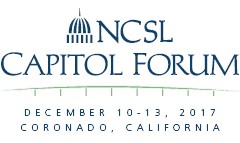By Deborah A. Good, PhD, ATR-BC, ATCS, LPAT, LPCC | January 11, 2018 | Advocacy | Events
The AATA was invited to participate in a panel presentation entitled “The Arts and Well Being Across the Military Continuum” at the National Conference of State Legislatures (NCSL) Capitol Forum in San Diego, California. I was honored to represent the AATA in this capacity and to speak on the pressing need for every state to pass licensure for art therapists. We extend a heartfelt thank you to Jay Dick, Senior Director of State and Local Government Affairs at Americans for the Arts for including art therapy in this important presentation.
The panel took place at 8:30 a.m. on December 11, 2017 during the breakfast session. Senator Terri Haverly (R-SD 35th District) co-chair of NCSL’s Labor and Economic Development Committee (where the arts are housed) and a member of the Military and Veterans Affairs Task Force moderated the panel discussion. An Air Force veteran herself, Senator Haverly is a very strong supporter of the arts and art therapy. Jay Dick gave an overview of the work being done by artists and creative arts therapists across the nation to support the military population. He also introduced the need for licensure that differentiates therapists who are trained to use the arts in therapy from traditional verbal therapists as well as from artists in the healthcare setting without qualification to provide therapy.

Rebecca Vaudreuil, EdM, MT-BT and Deborah Good, PhD, ATR-BC, AATA Past-President after their panel presentation.
Rebecca Vaudreuil, EdM, MT-BC co-presented with a military veteran who had experienced severe traumatic brain damage when demonstrating a dangerous maneuver during a training mission. He credits the success of his recovery to music therapy. Because of his therapy with Rebecca, he continues to write music and is able to connect with his daughter through the music he creates. This presentation was very moving and emphasized the importance of connecting through the arts when verbal skills are limited.
I presented on the power of art therapy as compared to traditional verbal methods of psychotherapy. I used examples of client artwork and emphasized the distinctive academic clinical training, which integrates the use of art media and the neurobiological implications of art making, that art therapists receive. I also discussed the growing need and urgency for art therapists to be licensed with title protection and within the appropriate scope of practice.
It was evident during the Q and A following the presentation that the legislators in attendance understood the clinical background and education required to become a Registered and Board Certified Art Therapist. The majority of questions and comments were either prefaced by a lack of knowledge that art therapists were not already licensed in all states or expressions of concern as to why this omission had been overlooked by state legislatures for so long.
Topics from the panel discussion were discussed further between legislators throughout the rest of the conference, and several other presentations also emphasized the healing powers of the arts as well as the need for inclusion of the arts in the military and other therapeutic settings. In many states, the movement to involve the arts in military functions is rapidly growing in acceptance, a trend that highlights the need to distinguish between the therapeutic power of trained art therapists and the involvement of the arts as a valuable cultural experience.
The time is ripe for art therapists to educate state leaders on the necessity of art therapy licensure, the difference between art therapists, counselors, marriage and family therapists, and social workers, and the current legislative movements in place to exclude art therapists from existing state licensure laws that will inhibit the ability of trained art therapist to practice.
Throughout every state there are numerous opportunities for art therapists to become involved in collaborations taking place between their State’s arts division within the Department of Cultural Affairs and the Department of Military Affairs. For example, through meeting the Program Coordinator for the New Mexico Department of the Arts at the recent AATA annual conference in Albuquerque, I was invited as a representative of my chapter, the New Mexico Art Therapy Association (NMATA), to participate in the NM Arts and the Military Roundtable discussion. Involving art therapists in more of these discussions can help promote state and national legislative efforts.
We can make a difference. We elect our state officials and ultimately, they count on our votes. In return, it is time for art therapists to ask legislators for their support. We can do this by getting involved with state arts organizations, getting to know our legislators, and exposing the value of art therapy within our communities through participation in community events. The AATA National Office is available to help you with ideas for how to get involved in your state.
